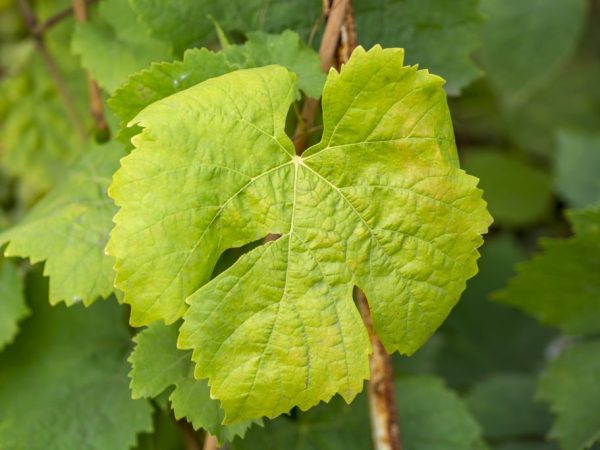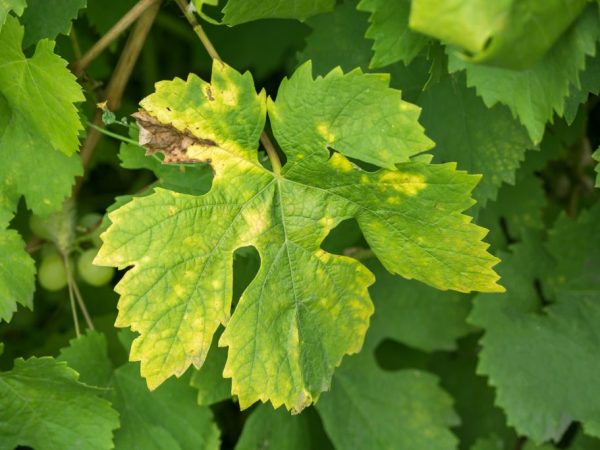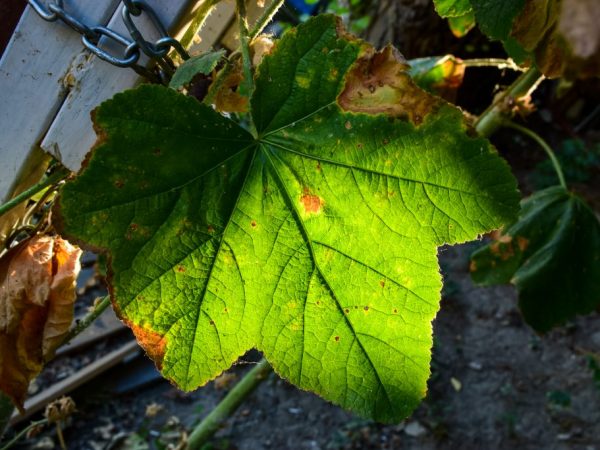Spots on the leaves of grapes
There are a large number of threats that grapes are exposed to when grown. Among the most common are spots on the leaves of grapes, which can appear for completely different reasons.

Spots on the leaves of grapes
Causes of spotting
The appearance of spots on grape leaves is due to many factors:
- improper care;
- spores of fungi, of which there are countless;
- pests that feed on the plant.
Among the great variety of grapes, there is no variety that can withstand disease. Diseases with symptoms of spotting:
- alternaria;
- anthracnose;
- midu;
- gray rot;
- oidium;
- black spot.
Hybrid varieties are also susceptible to damage if significant mistakes were made in the care.
Types of spotting
Spots can appear on both leaves and berries, and have a wide range of colors. But they all mean the presence of an ailment on the plant.
Yellow spots
The appearance of yellowish streaks on various parts of the plant signals the appearance of mildew. This disease is dangerous.
Downy mildew affects almost all types of European varieties, but American ones are least prone to it.
It is difficult to notice the disease at an early stage, since it is manifested by a barely noticeable lightening of the affected areas on the leaf plate. The main localization of oily yellow spots is the upper side of the leaves. On juveniles, the spotting is expressed in rounded shapes, and on coarser ones - in angular shapes located near the veins. The reverse side of the leaf plate is covered with a shiny, pale bloom of mycelium.
Mildew infects the whole plant. Yellowing is visible on:
- the tops of the shoots;
- antennae;
- inflorescences;
- combs and young berries.
The disease is characterized by a rapid spread, as the fungus is carried by the wind. Start treatment immediately. It is important to prevent the spread of mildew to neighboring specimens, since the yield with such a disease will be much lower.
Brown spots

Disease can ruin crops
Brown spots on the leaves of grapes are a sign of anthracnose fungal disease. Development is activated during periods of high humidity. In dry summer, the spread of the disease stops.
Symptoms of anthracnose on grapes:
- Small brown-brown spots with a white edging appear on the leafy part, which gradually increase in size and merge together. The central part of the affected area dries up and dies off, thereby leaving many holes.
- Shoots are covered with necrotic spots of light brown color, slightly deepened from below. Darkening over time, they acquire a purple border. Ulcers appear at the sites of the lesions, deepening to the very core. In this case, the shoots dry out and break.
- The inflorescences change color.They acquire a brown hue and gradually dry out.
- The berries are covered with brown or dull-brown spots with a dark border, becoming angular or rounded. Affected berries are deformed and dry out before ripening.
White spots
Vine leaf spot can also be caused by powdery mildew or uncinula. White spots can be ashy, silvery and appear on the inside of a grape leaf.
The fungus feeds on the sap of the plant, therefore, with a lesion in the form of a white bloom, the deciduous part gradually dries out and falls off, and the fruits crack.
If the disease is not eliminated in time, then the dusty layer accumulates, creating a thickened felt structure. Lesions with white spots on grape leaves have an unpleasant and pronounced rotten smell.
Black spots
Dark necrotic spots, resembling leaves burnt to charcoal, are a sign of Alternaria.
Leaf spot appears gradually. Fungal bloom appears on the vine from all sides, and on the berries they shine with a metallic sheen. The disease develops in wet and warm summer weather.
Vine bushes die with lightning speed if Alternaria is not detected in time.
Red spots
Red spots on the leaves of grapes are often a sign of non-compliance with the cultivation rules for a particular species. This disease has another name - rubella.
The nature of the infection is mostly non-infectious, but it can also be infectious. The disease affects only the upper part of the bushes and manifests itself in such cases:
- lack of potassium;
- low humidity;
- prolonged drought.
The appearance of spots of red shades indicates the defeat of insect pests. A burgundy red lesion signals damage to the plant by a felt mite. A lumpy and pinkish bloom on the lower part of the leaf plate is a sign of an attack of grape itch.
Rusty stains

Rust must be fought
Orange and rusty brown spots on the grapes signal a rust attack on the grapes. Fungal spores on the affected area look like orange pads.
Consequences of rust:
- loss of moisture;
- metabolic disorder;
- deterioration in the process of photosynthesis;
- reduced sprout;
- death of the plant.
If you do not fight rust, then the disease spreads to all above-ground areas of the grape bush.
Disease control measures
Treatment of grapes will be successful only with an integrated approach. In the fight, you need to use chemicals, having carried out agrotechnical work before that.
Agrotechnical measures
The complex of this type of work includes measures for growing healthy bushes. For some diseases this will be prevention, for others it will be prevention. It includes:
- timely pruning of shoots;
- improved air circulation between grape stems;
- tying, strengthening and thinning bushes;
- digging row spacings;
- soil moisture control;
- weed control;
- burning contaminated parts after trimming.
Chemical treatment
The plant can be treated by spraying with copper sulfate - 1 g of powder per 1 liter of water. Then they use fungicides against this or that type of disease:
- Preparations for combating mildew are used for spraying vines: Cuprikol, Hom, Arcerid, Kurzati Delan. These drugs show high rates of effectiveness and are fast acting. Young grapes need to be processed more frequently. In the spring, spraying is carried out every decade, and from mid-June, weekly.
- To treat rubella, add fertilizers containing potassium to the soil or treat it three times with 1% nitric acid potassium. Spraying should be done before sunrise or late in the evening.
- Uncinula begins to heal when 3-4 leaves appear. The bushes are sprayed with a colloidal sulfur solution at the rate of 45 g per 5 liters of water.Processing should be repeated after flowering. Additionally, drugs are used: Kurzat, Topaz, Ordan, Fundazol.
- To remove rust, treat the grape bush with the Strobi fungicide in a ratio of 1 g to 2 liters of liquid. Re-spraying is carried out after 2 weeks.
- In the fight against pests, it is necessary to spray the stems with acaricidal agents: colloidal sulfur, Neoron, Amitraz, Confidor.
Please note that after treatment with fungicides, the consumption of berries is prohibited.
Folk remedies
Traditional methods are not as effective for medicinal purposes, but their use is safer. Often they are used as an additional remedy to reduce the parasitic effect of fungal spores on grapes. Popular means are considered to be:
| Means | Quantity per 10 liters of water | Application |
| Mullein herb infusion | 150 g of grass. Insist for 3 days. | Spraying with a solution of the ground part of the grape bush. |
| Potassium permanganate | 4g of powder. The liquid should be pinkish in color. | |
| Milk | 1 liter of milk. | |
| Laundry soap with soda ash | 25 g soap and 30 g baking soda | |
| Ash | 1 kg of raw materials. Insist 5 days. At the end add 20 g of grated soap | |
| Tansy decoction | 300 g of chopped or 30 g of dry culture. Insist for 24 hours, then cook for 2 hours. Refrigerate before use. | Treat the soil with undiluted infusion. |
Conclusion
To prevent spotting of the leaves of grapes throughout the season, carry out careful and proper care of the plant, and also do not forget to take preventive measures with effective means.


